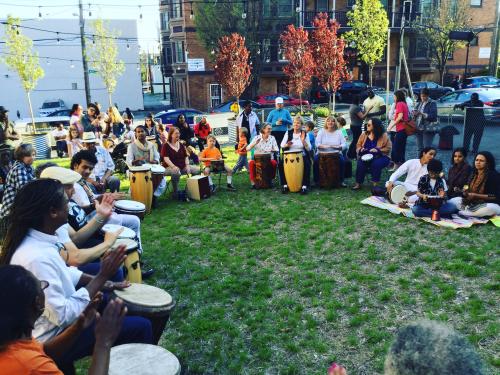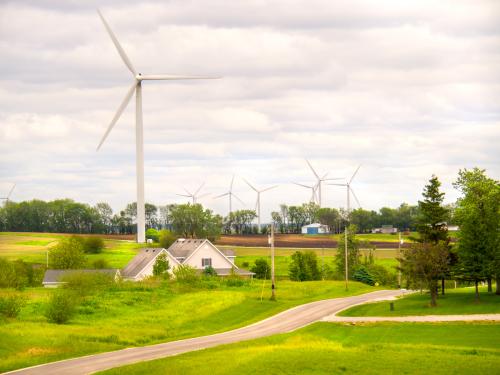Placemaking Postcards is a blog series from the Bass Center for Transformative Placemaking at Brookings where policymakers and practitioners guest-author promising placemaking efforts from across the U.S. and abroad that foster connected, vibrant, and inclusive communities. In line with the principle tenets of placemaking, the goal of the series is to recognize the community as the expert, highlight voices from the field, and to create a community of learning and practice around transformative placemaking.
The problem of food insecurity is deeply connected to our nation’s spatial patterns of economic inequity. Widening geographic divergence—in which smaller and more rural areas, on the whole, face higher poverty rates, greater unemployment, and limited access to economic opportunity compared to denser metropolitan areas—alongside steep declines in grocery stores serving rural areas in recent years have contributed to a devastating paradox: Despite growing most of our nation’s food, rural communities are disproportionately likely to be food insecure.
This paradox produces severe consequences for rural residents, including higher rates of hunger, diminished health outcomes, and even lower grades and educational achievement. These consequences—on top of limited access to public health services and hospitals—put residents of rural areas particularly at risk during public health shocks, including the COVID-19 pandemic.
One pilot program in rural Wisconsin is striving to eradicate such disparities by embedding hyperlocal food production in everyday community spaces. This will not only provide access to fresh produce, but foster a culture of local food ownership, supply chain transparency, and healthy living that will last for years to come.
Promoting hyperlocal food production and ownership
The farm-rich state of Wisconsin is far too familiar with the challenges of food insecurity. Access to grocery stores is limited for low-income residents in both urban and rural areas, with dollar stores and gas stations often functioning as de facto food sources. Food access is particularly challenging in Rusk County, a rural area where 20.6% of children are food insecure and 96% of families are income-eligible for nutrition-based programs. These challenges have been exacerbated by rising food insecurity amid COVID-19.
To combat hunger in the Rusk County—and pilot a model for reducing rural food insecurity statewide— two Wisconsin-based organizations decided to look locally for solutions, turning to community centers, schools, child care centers, and other local civic organizations to provide residents with the tools and skills to grow their own healthy, fresh produce. Employing the principles of hyperlocal food production—a food access strategy meant to promote food security, transparency in agricultural supply chains, and environmental sustainability—Fork Farms and the Marshfield Clinic Health System are partnering to place indoor vertical hydroponic farming systems in critical community spaces, and combining farming systems with educational programming on healthy eating, innovation, and sustainability.
Fork Farms provides the hydroponic farming equipment (including the water systems, energy-efficient LED lights, submersible pumps, grower toolkits, and starter supplies), the health-oriented curriculum, and volunteers to assist with each site. Marshfield Clinic provides the funding and countywide connections to place the systems in community spaces such as community centers, K-12 schools, child care centers, thrift stores, and senior centers. This partnership allows food-insecure residents with minimal farming experience to produce (and own the production of) their own healthy foods. It also provides hyperlocal access to food production at a scale that can not only feed individual families, but supplement entire school lunch programs with healthy produce.
Overall, the pilot program—which we launched in December 2019 and are expanding daily amid the pandemic—is showing initial success at hyperlocal food production and supply chain transparency in a food-insecure community.
Thinking differently about rural food access
Although home to plenty of farmland and green space, access to healthy food in rural areas remains a persistent problem—one that COVID-19’s devastating effects have only magnified. Some ways to advance strategies to address these challenges through hyperlocal food production include:
- Partnering across sectors to reduce barriers: To get the tools for hyperlocal food production in the hands of community members in remote rural areas, we needed to partner with a trusted health organization and the local community-based organizations where residents already spend their time. By bringing low-maintenance food production to schools, senior facilities, and other local spaces, we’ve helped reduce the burden (including travel time and costs) for residents to produce their own food, and furthered cross-sectoral partnerships across organizations to help meet residents’ multifaceted needs in common places. This has required adaptability amid COVID-19’s social distancing requirements in community spaces, but our farm systems have remained accessible— and increasingly vital—during the pandemic.
- Identifying local champions to maximize impact: Since the start of the pandemic, we have scaled the pilot program from its 13 initial community sites to 15 more community spaces. Additional funding from our health system partner was critical in achieving this, but so too was the dedicated work of local “champions” at each site who lead the fresh food program, coordinate volunteers to plant and maintain the farm systems, and help harvest and distribute the food. By having one site champion overseeing the farm system, we’ve been able to increase productivity—producing over 20 pounds of leafy greens in each site every month—and have made residents feel more comfortable asking questions, learning, and eventually taking ownership over the process and growing their own food.
- Fostering a culture around local production: Hyperlocal food production is often used in urban areas, with urban farms and gardening coalitions meeting residents’ needs in food deserts. But the need for hyperlocal production persists in remote, farm-rich areas too. By giving rural residents hands-on knowledge on how to grow their own food, eat healthily, and the importance of supply chains, we are gradually empowering rural residents to gain ownership of the food production process, adopt longitudinal health behaviors, and adapt a food access solution to their own place-based context.
During the COVID-19 pandemic, it’s more important than ever to increase food access and empower communities to understand where and how their food is produced. By embedding tools for food production within community spaces, pairing farming systems with health-based education, and fostering a culture of local production, we’re advancing a sustainable, replicable model for improving food access and holistic health in rural areas. As communities continue to face new health and food access challenges each day, we hope to expand our model to additional sites and ensure that fresh, locally produced goods are an integral part of recovery.
Photo credit: Fork Farms









Commentary
How rural Wisconsin is embedding hyperlocal food production in community spaces
July 16, 2020